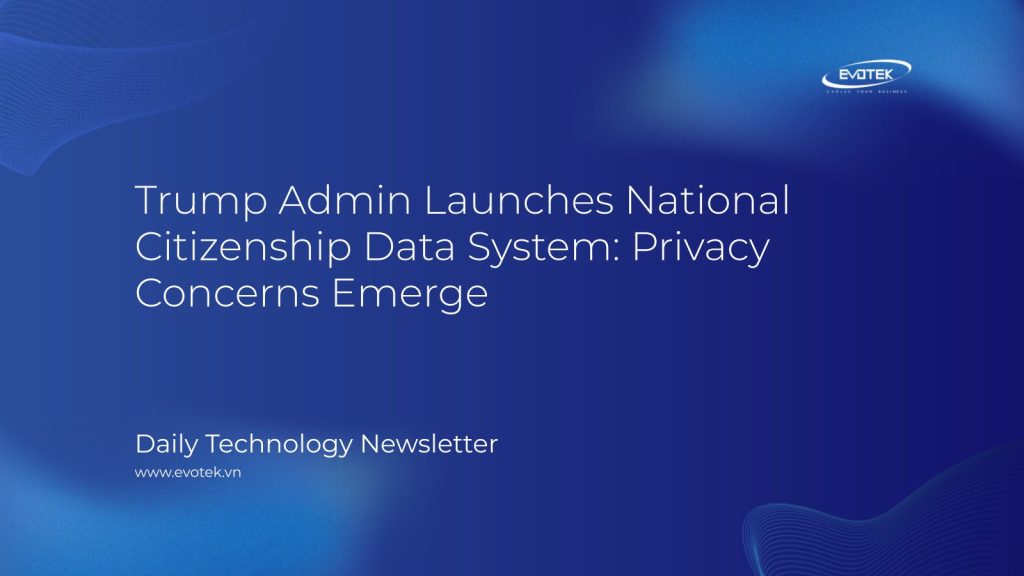The Trump administration has quietly rolled out a groundbreaking national citizenship data system, sparking both excitement and alarm among election officials and privacy advocates alike.
This searchable tool, the first of its kind, aims to streamline the process of verifying voter citizenship at the state and local levels. However, its rapid development and lack of public transparency have raised serious questions about potential privacy violations and the scope of its use.
A Solution to a Long-Standing Problem?
For years, election officials have struggled with the challenge of verifying voter citizenship. The absence of a national citizenship list forced them to rely on methods that could potentially disenfranchise eligible voters, such as requiring birth certificates or passports, or using complex, fragmented data sources.
Now, the Department of Homeland Security (DHS), in collaboration with the White House’s Department of Governmental Efficiency (DOGE), is offering a new solution: upgraded federal databases that allow election officials to quickly check the citizenship status of voters using data from the Social Security Administration and immigration records.
A “Sea Change” with Unclear Consequences
Experts are calling this integration a “sea change,” bringing the U.S. closer to a national citizen roster, a concept that has historically faced strong opposition. Privacy advocates and political conservatives have long opposed the consolidation of personal data by the federal government.
Legal experts express concerns about the lack of transparency and public discourse surrounding this development.
“That is a debate that needs to play out in a public setting,” argues John Davisson, director of litigation at the Electronic Privacy Information Center. “It’s one that deserves public scrutiny and sunlight, that deserves the participation of elected representatives, that deserves opportunities for the public to weigh in through public comment and testimony.”
Danielle Citron, a law professor at the University of Virginia, describes the data aggregation effort as a “hair on fire” development, questioning its legality.
Unanswered Questions and Potential Pitfalls
Several crucial questions remain unanswered, including:
- Which states plan to utilize the system, and how?
- What data security measures are in place?
- How reliable is the data provided by the tool?
- What will the federal government do with voter records processed through the system?
Past data matching efforts in elections have often been plagued by inaccuracies, leading to the entanglement of eligible voters. The current administration’s history of promoting false claims about noncitizen voting further fuels concerns about the tool’s potential for misuse.
Kim Wyman, former Republican secretary of state of Washington and current senior fellow at the Bipartisan Policy Center, emphasizes the importance of accuracy.
“We’ve never had a list of U.S. citizens to compare our voter registration lists to,” she says. “It seems like it takes the federal government more than just [a few] months to be able to make a comprehensive national database of information that’s going to be accurate … That’s what my concern is, just first and foremost, that the list is accurate.”
How the System Works: SAVE Expansion
The new citizenship check capability is built upon an expanded version of the Systematic Alien Verification for Entitlements (SAVE) system, a DHS database used since the 1980s to verify the immigration status of noncitizens. Previously used sparingly by voting officials, SAVE now integrates data from the Social Security Administration, allowing for citizenship verification of both U.S.-born and naturalized citizens.
The integration of Social Security data is a key development, transforming SAVE from a tool focused on foreign-born individuals to one capable of scrutinizing entire voter lists.
Data Accuracy and Quality Control
While the system holds promise, experts emphasize the need for robust quality control measures to address potential errors arising from the comparison of vast datasets. Challenges exist, such as lags in updating naturalization records and limitations in verifying certain foreign-born citizens.
USCIS acknowledges these limitations, stating that any non-confirmation of citizenship requires manual review and voter contact to provide proof of citizenship.
Concerns also extend to the reliability of data from the Social Security Administration, as citizenship tags were only added to records relatively recently.
Political Divide and Privacy Concerns
The Trump administration’s data consolidation efforts, led by DOGE, have faced criticism, particularly from Democrats. The historical concern from the right regarding big government and data collection seems less pronounced in this instance.
Catherine Engelbrecht, founder of True the Vote, acknowledges the potential benefits of SAVE but expresses unease about the centralization of federal databases.
“Such centralization of data poses a threat to individual freedoms and privacy,” she writes. “Surrendering our data to unchecked power isn’t just a technical risk — it’s a moral failure.”
The Future of Voter Data
The long-term fate of voter data uploaded to SAVE remains unclear. USCIS retains records of SAVE queries for 10 years but has not clarified whether it will store copies of state voter rolls or use the information for criminal or immigration investigations.
A state election official, speaking anonymously, expressed concern about the potential for using state-provided information in immigration enforcement efforts, predicting a partisan divide in system adoption.
As this new national citizenship data system unfolds, its impact on voter integrity, privacy, and public trust will be closely watched.

 日本語
日本語 한국어
한국어 Tiếng Việt
Tiếng Việt 简体中文
简体中文